#Public Relations Vancouver
Text
THE PERMANENT RAIN PRESS INTERVIEW WITH CATHERINE LOUGH HAGGQUIST

Catherine Lough Haggquist is a seasoned veteran in the film industry, with experience far beyond the reach of the silver screen. She is an entrepreneur – the owner of two businesses offering education and resources to creatives – and an advocate for the industry at large. Her passion is reflected in her work and dedication to her craft.
You star as Petra Bellweather in Motherland: Fort Salem, now airing its final season. What can you share about Petra’s story as the season progresses?
At the end of last season, we see Petra experience a really bad first few days on the job. Things seem like they have hit rock bottom for her and could not possibly get any worse. And then they do. And do. And do some more.
Petra is being tested on every front this season, as a mother, as a leader, as a political force, and as an individual. She moves from moment to moment and episode to episode simply trying to make the “next right decision” all while trying to sort out which of the many competing interests and responsibilities needs to be prioritized in that moment. I remember approaching each new script with a sense of tense anticipation about what Petra would be put through next. It was a wild ride for me as an actor and I hope an exciting one for the audience.
Tell me about working opposite Ashley Nicole Williams as your on-screen daughter, Abigail. Have you enjoyed the changing dynamics of their relationship?
I remember the first day I met Ashley! I was walking through the production office, excited and a bit nervous about what lay ahead and I saw this tall, beautiful young woman sitting at a conference table. As I approached, unsure of where I was going, she looked up from what she was reading, fixed her gaze on me, broke into a big grin and exclaimed “You must be my Mom! Hi! I’m Ashley!”
I smiled back and that was it. We were bonded. It has been a delight to watch her mature and grow both as a woman and as an actor. I think our dynamic on screen is based on the affection and respect we have for each other off-screen and I am grateful that our relationship was written with challenges but always love and connection. I have also enjoyed seeing how close Ashley and the other young women on the show have become. In a business that often encourages unhealthy competition between actors, it has been a joy to see (and experience) the bonds and friendships that have been formed on this show. I look forward to keeping in touch with Ashley and she knows she always has an extra back-up mom whenever she needs me.

What has this character taught you about yourself, as both an artist and human?
Petra taught me a lot about strategy, clarity, power and patience. But even more than those elements, I think the most important quality of Petra’s is that is an example of what I believe Dr. Maya Angelou was speaking to with her quote “Do the best you can until you know better. Then when you know better, do better.”
Often characters with power, especially women with power, aren’t given the grace to evolve and change with understanding or new information. They remain locked in the beliefs that they perceive to be directly linked to their strength and success. That Petra evolved over the 3 seasons and was not diminished in that evolution (as so often happens in film & TV), but had her new knowledge enhance the work she had done prior making her even more effective is, I think, a very meaningful example both for us to share with the audience but also for me personally.
The series has been ground-breaking in how it empowers female voices and their strength, while building an inclusive world. You’ve discussed how the power of Black women is celebrated in the show. What legacy do you hope it leaves in film and TV?
I think that the main legacy of the representation of Black women’s strength, leadership, intellect and power in Motherland: Fort Salem will be questions like this, in forums like this, which draw the lens of reflection and amplification to the contributions Black women make and have ALWAYS made to society, and in specific, American and Canadian society.
Black women have long been woven into the fabric of the work and fights for social justice. Now, increasingly, we are being seen and recognized for our contributions to and excellence in many other arenas and Motherland: Fort Salem assists in normalizing these contributions as the become acknowledged, appreciated and expected.

What message do you have for the passionate fans who have championed these characters over the past few years?
Thank you!
Thank you for recognizing and appreciating the intricacy of the storytelling, and the diversity of the characters. I think the allegorical nature of Motherland: Fort Salem and how it interpreted through this fictional lens so many of the challenges facing the world right now, combined with the representation of so many layered and interesting individuals navigating this world generated the following that has been so embracing of us and our work.
Seeing how many people personally identified with different characters was another lesson in how much representation matters when it comes to who we see on our screens.
I truly believe that it was because the fans returned so much love and enthusiasm to us that allowed for us to be given the gift of bringing the series to a meaningful conclusion. And so I thank the fans for that opportunity too.
You’ve also appeared as a guest on a number of fan-based podcasts to discuss the show and your story. How special has it been to discuss theories, and speak to others who have supported the show since the beginning (and maybe know the characters better than the cast themselves)?
Unlike theatre, where you receive immediate feedback from and have interaction with your audience, film and television production takes place far away in both location and time from where and when the audience watches. As such, the opportunities to interact with the people who are watching is much more limited.
Social media – in particular Twitter and Instagram – have been wonderful ways to connect with the folks who are as captivated by and invested in the world of Motherland: Fort Salem as those of us bringing that world to life. Seeing their theories, fan art, appreciation posts, edited montages... all of it has been super fun and is received gratefully and humbly. And to get to meet and interact with so many of them through social media, their podcasts and Discord groups has been awesome. On top of all of that, the campaign that the fans launched to save the show was incredible. To know people are willing to go to that level of expense and effort in support of your work is truly a wonderful feeling.
Do you have a favourite behind the scenes memory from the set of Motherland?
One of my favourite elements of the promotion of each new season has been the release of our “blooper reels”. It is fun to be reminded with the footage of how much laughter we shared and how much we all enjoyed working with each other. So I would say my favourite memories are also connected to what I will miss most now that we are done, laughing with my friends and enjoying each other’s company.
Do you have any upcoming projects you can share with us?
I just finished working on an independent feature film and while the details are still being kept quite under wraps, it was an extremely fun experience and I look forward to when I can share more information about it.
That said, I can say that it was both a very different world from Motherland: Fort Salem and a very different character from Petra so it was nice to move from being sad about the end of Motherland into creating a new story with another wonderful group of people.
You also have a passion for educating and community building through the arts. Tell me about Biz Books and The Drama Class, and the importance of these platforms to you and your work.
We started Biz Books in 1996 as a brick and mortar bookstore in Vancouver’s Gastown district. We moved to our second location in 2001 and we operated in that neighbourhood until 2010 when we transitioned the storefront to BizBooks.net and our current “Online and On Location” format where we now serve customers all over the world and create pop-up shops at local industry and educational events.
In 2020 when acting classes migrated to the internet due to the pandemic, we discovered that there was much to be explored in the online training space. In September 2020 we acquired TheDramaClass.com where we now develop classes, workshops and coaching plans to assist actors, writers, directors and teachers to develop skills and knowledge to help them achieve their creative professional goals.

If you had to pick one, what is your personal favourite book for actors looking for inspiration and to bring their career to a new level?
It may surprise you but the book that I think is essential for actors and other independent creative freelancers to read to level up their careers is “Atomic Habits” by James Clear. A dear friend gave it to me as a Christmas gift and it has proven to be a game changer for me.
As I work to be more intentional with the habits, patterns and systems I am creating, I also become more aware or the progress I am making daily which is so vital to recognize, especially with the ebb and flow of gigs. Focusing on maintaining the habits and behaviours of the person I am working to become, and narrowing the focus to being 1% better everyday, makes it possible to keep going when times are tough and to get back into a routine after the whirlwind of things going well.
In a business that can sometimes feel like everyone else holds the power, it is nice to have a guide to establishing and maintaining personal agency and accountability for the results we are seeking.
You’ve been a mainstay in Hollywood North for the past 30 years now, and have amassed a rich resumé of projects in British Columbia (in addition to many talented friends). What does it mean to be a part of the BC film industry, and noticing its growth and changes over the years, notably in female-led projects?
I have been proud to be a part of the BC film industry and to know that I have contributed to the efforts of so many in growing the business here. The community of artists and technicians based here are world class and second to none. Helping to promote them and their achievements through my union, board and committee work makes the heights that we have attained together so very satisfying. And to have the ability to stay here, close to friends and family, while still pursuing my artistic and career goals as an actor, makes me feel truly blessed indeed.
The advancement of women in both profile and leadership has been undeniable. When I started, female producers were few and female directors were rarer still. Seeing the expansion in the diversity (race, gender, orientation and more) of creative leaders, benefits us all as we tell stories from the context of our experiences and amplify what we see through that lens. The more variety we have in the visions being shared, the more enriched, inspired and empathetic we become. All while still being excited and entertained!
What are some of your favourite places to visit and/or eat at in Vancouver?
I am a HUGE sushi fan so I have a mental list of faves arranged by neighbourhood and price point! Shiro Sushi, Tojos, Minami, Manna Sushi, Yanaki Sushi are on my Vancouver list and I also really like Taka’s Sushi in White Rock and Sushi Mori in South Surrey.
Other favourite spots in Vancouver are Burgoo, Les Faux Bourgeois, and The Patty Shop. And closer to my home in White Rock, Kiki’s Greek Restaurant, Three Dogs Brewing, Pho 777 Vietnamese and the Wooden Spoon are my local haunts.
Our signature question – if you could be any ice cream flavour, which would you be and why?
I think I would be Butter Pecan. A unique flavour that is not too overwhelming and that is smooth most of the time but also little nutty. Kind of sums me up, I think.
-
We appreciate Catherine taking the time to answer our questions! Motherland: Fort Salem has had a remarkable run and its impact will not soon be forgotten. To keep updated with Catherine’s projects and activities, visit her website, Facebook, and follow her on Instagram.
Photo credit to: Shimon (cover) and Disney Enterprises (Motherland: Fort Salem)
#entertainment#interview#actor#Catherine Lough Haggquist#NovaCurrent Public Relations#NovaCurrent#Motherland Fort Salem#Motherland: Fort Salem#Motherland#Freeform#ABC Spark#Hollywood North#Vancouver#yvr#Petra Bellweather#Motherland Season 3#bc film#TV#film#Ashley Nicole Williams#Abigail Bellweather
13 notes
·
View notes
Text
Things Biden and the Democrats did, this week.
January 19-26 2024
The Energy Department announced its pausing all new liquefied natural gas export facilities. This puts a pause on export terminal in Louisiana which would have been the nation's largest to date. The Department will use the pause to study the climate impact of LNG exports. Environmentalists cheer this as a major win they have long pushed for.
The Transportation Department announced 5 billion dollars for new infrastructure projects. The big ticket item is 1 billion dollars to replace the 60 year old Blatnik Bridge between Superior, Wisconsin, and Duluth, Minnesota which has been dangerous failing since 2017. Other projects include $600 million to replace the 1-5 bridge between Vancouver, Washington, and Portland, Oregon, $427 million for the first offshore wind terminal on the West Coast, $372 million to replace the 90 year old Sagamore Bridge that connects Cape Cod to the mainland,$300 million for the Port of New Orleans, and $142 million to fix the I-376 corridor in Pittsburgh.
the White House Task Force on Reproductive Healthcare Access announced new guidance that requires insurance companies must cover contraceptive medications under the Affordable Care Act. The Biden Administration also took actions to make sure contraceptive medications would be covered under Medicare, Medicaid, CHIP, and Federal Employee Health Benefits Program. HHS has launched a program to educate all patients about their rights to emergency abortion medical care under the Emergency Medical Treatment and Labor Act. This week marks 1 year since President Biden signed a Presidential Memorandum seeking to protect medication abortion and all federal agencies have reported on progress implementing it.
A deal between Democrats and Republicans to restore the expand the Child Tax Credit cleared its first step in Congress by being voted out of the House Ways and Means Committee. The Child Tax Credit would affect 16 million kids in the first year and lift 400,000 out of poverty. The Deal also includes an expansion of the Low-Income Housing Tax Credit which will lead to 200,000 new low income rental units being built, and also tax relief to people affected by natural disasters
The Senate Foreign Relations Committee voted for a bill to allow President Biden to seize $5 billion in Russian central bank assets. Biden froze the assets at the beginning of Russia's war against Ukraine, but under this new bill could distribute these funds to Ukraine, Republican Rand Paul was the only vote against.
The Senate passed the "Train More Nurses Act" seeking to address the critical national shortage of nurses. It aims to increase pathways for LPNs to become RNs as well as a review of all nursing programs nationally to see where improvements can be made
3 more Biden Judges were confirmed, bring the total number of Judges appointed by President Biden to 171. For the first time in history the majority of federal judge nominees have not been white men. Biden has also appointed Public Defenders and civil rights attorneys breaking the model of corporate lawyers usually appointed to life time federal judgeships
#good news#thanks Biden#Joe Biden#Democrats#politics#us politics#climate change#abortion#reproductive rights#child tax credit#judges
600 notes
·
View notes
Text
Today's drabble is 'First Kiss'. This is a quick little drabble set in the Moonlight Serenade universe. This is from Padmé's POV during a visit back home. Takes place summer 1952~
---
Padmé wondered if Anakin knew about all the subtle ways Obi-Wan cared for him.
She wondered if he knew that Obi-Wan always stood to his right, their shoulders brushing, only a few inches of space between them as they navigated through crowds and public spaces. That it was Obi-Wan who protected Anakin’s injured side, blocking it from view and from touch, always mindful of where he was in relation to Anakin’s arm, keeping it safe within the shadows of his form.
Or how when Anakin’s manufactured bravado and fake cheer would wear down, instead replaced with weariness and irritation, Obi-Wan would tilt his head upward just to hear Anakin’s soft voice grow ever softer, and to breath in the words Anakin spoke. Obi-Wan never asked Anakin to speak up, to put on a show, to smile and laugh and coddle those he normally might disappoint. Instead he changed his own demeanour to fit that of Anakin’s, bringing his energies down until they swayed together like reeds in a lake.
Or when Anakin’s smile became tight, his shoulder tense, his eyes glassy with pain, Obi-Wan would grip his residual arm and hold. A friendly gesture, to the unknowing gaze, but filled with so much love and care it sometimes hurt to see. Obi-Wan would replace Anakin’s pain with something else to focus on - the stern yet still tender touch of a lover. The ache in his arm and the stinging in his skin would be replaced with the heat of Obi-Wan’s palm and the strength in his hand, grounding and steady as Anakin trembled through the memories of an agony not yet finished.
She knew, of course, Anakin noticed the most obvious things. Like how Obi-Wan would hold his plate at dinner events and pile it high with foods, asking Anakin what he wanted as they went down the tables, making sure Anakin’s belly was sated before he’d see to his own needs. Or how he tied Anakin’s tie and helped with the laces of his shoes when asked; how he styled his hair in the morning, and ruined in the evening; how he shaved along the curve of Anakin’s jaw and down the stretches of his neck; or how he cut the meats and vegetables for their dinners while Anakin did what he did best in the kitchen - make a mess.
And other stills, that Obi-Wan didn’t know she knew. Things more intimate that Anakin would confess over the phone, his voice bright with cheer as he detailed the latest night of passion, Padmé curling the phone cord over her finger as she laughed and sneaked glances into the living room to make sure no one could overheard the detailed descriptions.
Padmé wondered if he knew. Because she did.
“Padmé?”
Padmé blinked and turned to her mother. They were stood on the back steps of her parents estate, summer sun shining down on the backyard party. Vancouver had rolled out the nice weather for her visit, the skies clear and the winds gentle, the smell of roses fresh in the air. She’d missed this.
“Sorry, mother,” she said, and kissed her cheek quickly before venturing down into the party, a tray of cocktails in her hand that she’d offered to take out to the party.
The grass was cool on her bare feet, and she greeted those she passed by with a smile and an offer of a drink. By the time she’d reached Anakin and Obi-Wan, the tray was empty save for two glasses of gin and tonic.
“Fancy a drink?” she asked.
Anakin’s hand was occupied by a plate with the leftovers of cake on it, so Obi-Wan - as was expected - took both glasses and raised one to her in appreciation.
“Lovely party,” Obi-Wan said. He glanced around the space, his aviators sitting on the bridge of his nose, hiding away his blue eyes that Anakin had described to Padmé more times than once all those years ago. “Thank you for inviting us.”
“You’re welcome, though I’m sorry I haven’t been able to chat much.”
“It’s been six years since your last visit,” Anakin said, the word ‘six’ sitting heavy in the air. “It’s natural people would want to spend time with you.”
His shrug brought Padmé’s attention to his shirt. It was a pretty green silk and short-sleeved, the lapels broad and the top few buttons opened. Padmé could see Anakin’s scars along his chest, and his residual arm poked out at the bottom of his sleeve, exposing it to the world.
“I like your shirt,” Padmé said.
Anakin smiled, though it seemed hesitant. “Obi-Wan bought it for me.”
Adoration filled Padmé then. Of course he had, because he knew Anakin wouldn’t buy it for himself. Because he still cared what others thought; still hid from the world despite it all; still faltered where confidence would be best.
But Obi-Wan knew how beautiful Anakin was, and made Anakin believe it. If only for a short while.
“Ani, I forgot my pocket mirror in my purse back inside. Could you go and grab it for me?” Anakin made move to leave, but Padmé stopped him to grab his plate, replacing it with the drink tray. “And take this back inside, will you? Give it to Samantha.”
Anakin rolled his eyes but did as instructed, his long legs carrying him quickly through the throngs of people. He still cut quite the image, broad shoulders and slim waist making him look more a model from one of the catalogs, than a mechanic with a penchant for hot-rod racing.
When she turned back to Obi-Wan, she didn’t have to see his eyes to know where he was looking.
“That shirt really does look lovely, doesn’t it,” Obi-Wan mused with a soft smile.
Padmé laughed and dragged him in for a kiss. It was quick and sweet, and when she pulled away the greys in Obi-Wan’s beard were painted in red lipstick.
“Padmé,” Obi-Wan mumbled, his cheeks a delightful pink that matched the ruby tones of her lips. He leaned a little in, voice low enough for her to hear. “Not that I’m not flattered, but I’m a married man.”
She giggled again, but when she gripped his arm and held she couldn’t help but squeeze down as she spoke, voice serious, her brows furrowed. “I just wanted to say thank you. For the things you do, the things you say. For who you are. Thank you.”
Obi-Wan’s smile softened, and he nodded quickly. “No need to thank me. But I cherish the sentiment all the same.”
When she pulled away she grabbed a napkin and passed it to Obi-Wan and took one of the gins from his grasp. By the time Anakin returned the lipstick had been wiped away, and Padmé watched as Obi-Wan quietly filled the empty space next to Anakin’s right side once more. She ended up keeping the gin and tonic, while Obi-Wan and Anakin subtly shared the one, lips placed over the spot where the other had drank, like a soft kiss shared between the pair, known only to the trio stood beneath the summer sun.
70 notes
·
View notes
Text




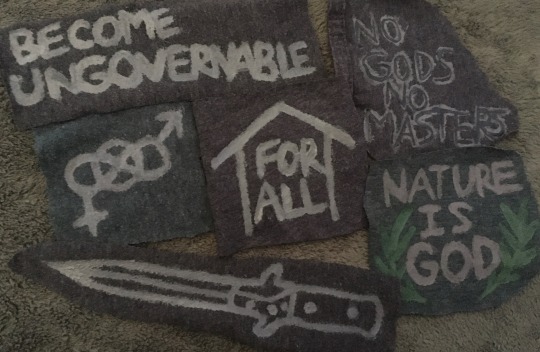
I just keep getting ideas for more patches, and they're fun to make!!
The crow patch is my favourite so far, it's based off of Canuck the Crow (a loveable crow from Vancouver, known for thievery, using public transit, defecating on police vehicles, and most of all: stealing a knife from a crime scene).
I've really enjoyed getting back into 2D art. I'd kind of avoided doing this type of art for a while, due to never really being proud of my work in this form.
But having more freedom now to make art as I please (without being related to work, a project or a certain theme to follow), I've been having much more of a good relaionship with my work! I'm actually quite proud of how things are turning out and how my style has developed :-)
#patches#diy patches#sew on patch#my post#my crafts#crowcore#crows#corvidcore#forestcore#cryptidcore#jersey devil#cryptid aesthetic#patchwork#gremlincore#witch#dirtcore#cottagecore#bugcore#bugs#fairycore#witchy#witchcore#punk diy#goblincore#punk fashion#goblin culture#cottage aesthetic#patch jacket#punk art#goblin community
209 notes
·
View notes
Text
Nora Hughes + Dad! Quinn
single dad x silly daughter
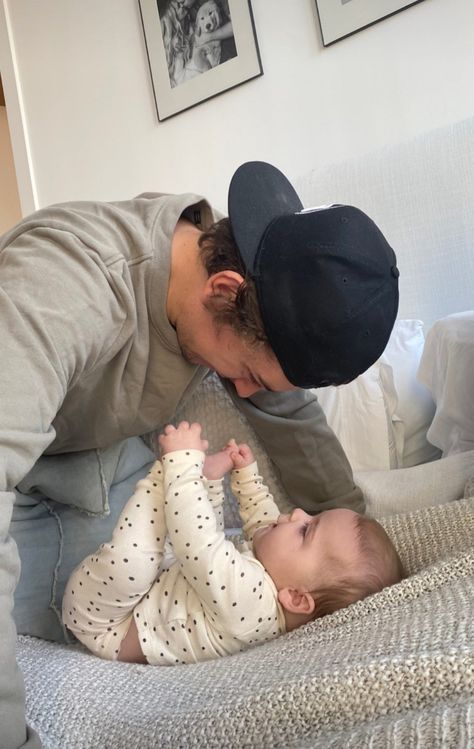


Nora Hughes
nora eleanor
born march 1st, 2020 in detroit, michigan
daddys little girl
Quinn Hughes
born october 14th, 1999
defenseman on the vancouver canucks
dad and captain of the year!
Time Line
january 2020
quinn finds out about nora
mom tells quinn its her baby and hes not going to be involved
march 2020
mom leaves nora in her carseat on ellen and jim’s front step when the world shuts down
causes panic but quinn does all the research and work and makes sure that he can be the best dad for his baby girl
january 2021
quinn goes back to vancouver with nora
august 2024
starts pre-kindergarten
no longer traveling with quinn
a really hard time for her and quinn cause shes been travelling with quinn since she was born
march 2025
nora has a severe allergic reaction during a home game
is severely allergic to tree nuts
july 2025
quinn has his day with the cup in michigan
layla y/l/n is there
more about her in their section
november 2028
teachers, coaches and layla start to notice that nora is not herself
shes tired fatigued and can barely play hockey
she even refuses to go out to practice
she passes out at school and ultimately gets diagnosed with type 1 diabetes
june 2029
amelia jordan hughes is born
nora is officially a big sister!!!
Dad! Quinn Hughes x Layla
Layla Y/L/N
ellen’s best friend and college roommates daughter
quinns first friend
lost contact when the hughes’ made the permanent move to michigan
gets a ba from university of southern california in communications and a minor in public relations
graduated in 2021 - summa cum laude
Quinn Hughes
born october 14th, 1999
defenseman on the vancouver canucks
dad to nora hughes
Time Line
june 2024
after 3 seasons in PR with the chicago bulls
gets a job with the canucks
july 2024
layla and her family attend quinns cup day!
she finds quinn in the kitchen and they reconnect
september 2024
quinn and layla run into each other during the first media day and quinn is shocked that shes there!
she and quinn reconnect and a friendship blooms
january 2025
make it official
february 2027
quinn proposes during all-star break
july 2028
married!!!
small wedding in michigan with their families and close friends
october 2028
layla officially adopts nora
june 2029
amelia jordan hughes is born on june 15th, 2029
nora is officially a big sister!!!
29 notes
·
View notes
Note
Hey I thought you might appreciate a heads up that the yellow-legged hornet (Vespa velutina) has been spotted in Savannah, Georgia. 😞
Nice. Well, not nice news. But glad that you thought of me. Thank you.

(For other people who have yet to fully embrace and explore their innate love of hornets, this Vespa velutina hornet is originally from Southeast Asia. This creature is closely related to Vespa mandarinia, the creature derisively referred to in the US as "murder hornet" or "Asian giant hornet", originally from South/East Asia, which is now apparently established near in the Salish Sea region near Bellingham, Vancouver, and Nanaimo.)
Here's a look at where the giant hornets now live in North America, along with the distribution of some other large hornets which might be mistaken as Vespa manadrinia/velutina:
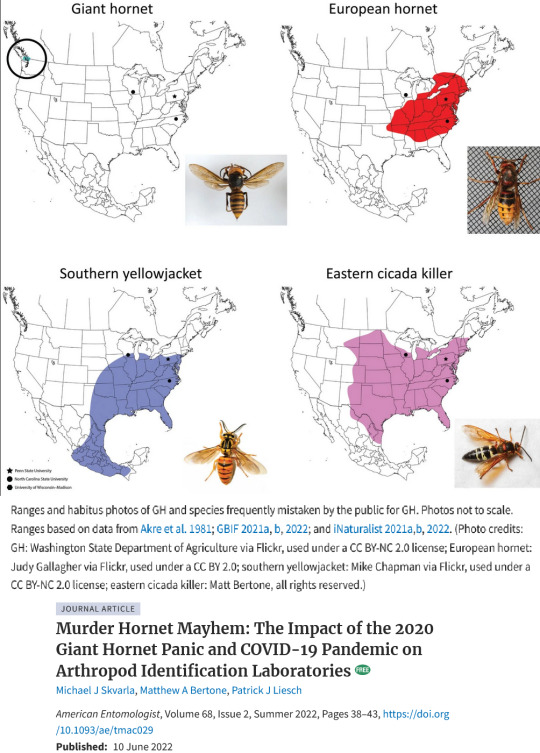
The map was originally published in 2022 in American Entomologist, displaying distribution range of (non-native) giant hornet; (non-native) European hornet; (native) southern yellowjacket; and (native) eastern cicada killer. The article also identifies a few few other species which might be mistaken for "murder hornets": great golden digger wasp, bald-faced hornet, German yellowjacket, red-legged cannibal fly, and pigeon horntail. (Available to read for free online; article title in the source/caption beneath the map.)
I've had many memorable encounters with large (native) bald-faced hornets in dense cedar-hemlock rainforest-y places. And coincidentally, the Pacific Northwest is also now apparently the North American home/homebase of Vespa mandarinia. So here are some other PNW wasps/hornets in comparison, from Oregon State University Extension Catalog (2022):
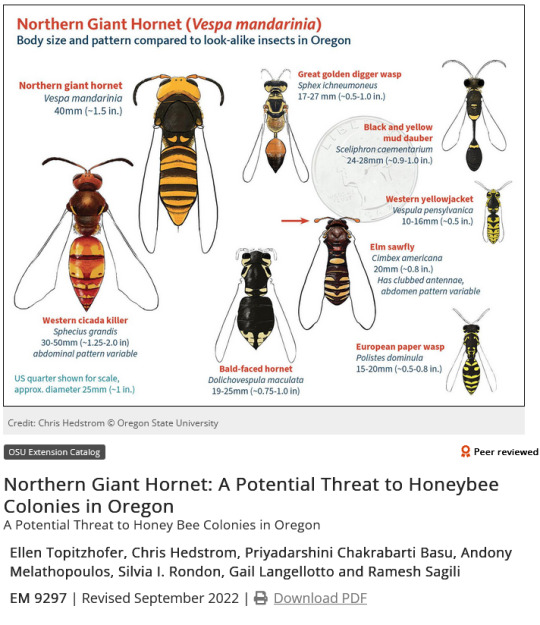
From 2020 research on potential dispersal of Vespa mandarinia over a couple of decades (not necessarily a good or realistic representation, not inevitable, kinda just "potential"):

Apparently Vespa mandarinia haven't yet been encountered outside of the general Vancouver area during targeted samples:
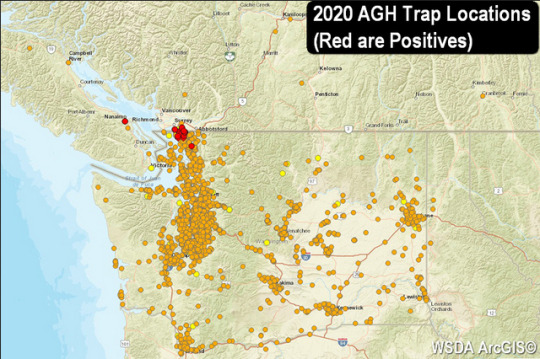
I know that you too are fond of wasps/hornets, and are aware of their popular demonization, the way that they're feared, etc. In July 2022, the Entomological Society of America put out an online resource thing that explains why they don't like the name "Asian giant hornet" for Vespa mandarinia and Vespa velutina, instead adopting "northern giant hornet" and "yellow-legged hornet" (which you called the creature, too!) because of the racialized/xenophobic implications. ("Northern Giant Hornet Common Name Toolkit" available at: entsoc.org/publications/common-names/northern-giant-hornet) They say: '"Murder hornet" unnecessarily invokes fear and violence, which impede accurate public understanding of the insect and its biology and behavior. While "Asian" on its own is a neutral descriptor, its association with a pest insect that inspires fear and is targeted for eradication may bolster anti-Asian sentiment in some people - at a time when hate crimes and discrimination against people of Asian descent in the United States are on the rise.'
Which, for me, brings to mind this recent book from Jeannie Shinozuka:

From the publisher's blurb: 'In the late nineteenth century, increasing traffic of transpacific plants, insects, and peoples raised fears of a “biological yellow peril” [...]. Over the next fifty years, these crossings transformed conceptions of race and migration, played a central role in the establishment of the US empire and its government agencies, and shaped the fields of horticulture, invasion biology, entomology, and plant pathology. [...] Shinozuka uncovers the emergence of biological nativism that fueled American imperialism and spurred anti-Asian racism that remains with us today. [...] She shows how the [...] panic about foreign species created a linguistic and conceptual arsenal for anti-immigration movements that flourished in the early twentieth century [...] that defined groups as bio-invasions to be regulated—or annihilated.'
A lot going on at that time with insects, empire, and xenophobia. In the 1890s, the British Empire was desperately searching for a way to halt malaria, and mosquitoes had just been discovered as vectors of malaria. And from Nobel prize podium lectures to popular media newspapers and academic journals, there was all kinds of talk about how "bacteria/viruses/insects are the greatest enemy of the Empire" and whatever. The US was also expanding in the Caribbean, Central America, Pacific islands towards East Asia, etc. Tropical plantations were proliferating, not just in Dutch Java or British India, but also in US administered Central America. And so insects were perceived not just as a threat to the human body of the British soldier or American administrator; insects were also a threat to profits, as insect pests threatened monoculture plantations and agriculture.
That same time period saw the US invasion of the Philippines and exports of products from the islands; the US annexation of Hawai'i, and elevating rivalry with Japan; the 1882 passage of the notorious Chinese Exclusion Act; US control of Cuba and Puerto Rico; expansion of US fruit corporations in Central America and US sugarcane plantations in Cuba/Hawai'i, where insect pests threatened plantation profits; the advent of "Yellow Peril" tropes and fear of invasion in science fiction literature; the detaining of half a million (mostly Chinese) people at the medical quarantine processing center that the US Public Health Service operated at Angel Island in San Francisco; and US insect extermination projects, mosquito control campaigns, and medical policing of local people in Cuba and the Panama Canal Zone (where US authorities detained local people for medical testing).
A lot to consider.
58 notes
·
View notes
Text
Rogers Sugar Inc. says it has asked for mediation to help bring an end to an eight-week long strike at its Vancouver refinery.
The company says it has applied to the British Columbia Labour Relations Board for mediation to help it reach a new collective agreement with the 138 workers who have been off the job since Sept. 28.
The company says the union, the Public and Private Workers of Canada Local 8, has accepted mediation.
The Rogers Sugar refinery in Vancouver is one of only three large sugar refineries in the country that processes imported cane sugar.
The strike at the Vancouver facility has led to supply disruptions on grocery store shelves across Western Canada and caused difficulties for bakers and other small businesses that rely on sugar.
Continue Reading.
Tagging: @politicsofcanada
43 notes
·
View notes
Text
By: Aaron Kimberly
Published: Dec 18, 2021
Between 1995-2006 I was a part of the butch lesbian community. During those years, despite my life-long and sometimes intense gender dysphoria, I hadn’t given any serious thought to medically transitioning. It wasn’t even on my radar as a possibility until after 2000. The idea of medically transitioning seemed fringe, far-fetched, and risky.
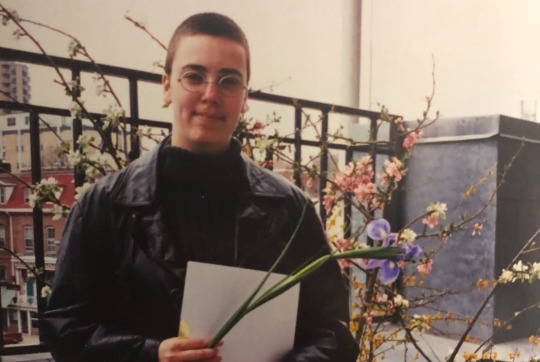
Most of the butches I knew also had gender dysphoria (GD) or rather, Gender Identity Disorder (GID), as it was called then. Many butches I knew in Winnipeg, Halifax, Toronto, and later Vancouver, were strong, stoic people. I admired many of them. I know that their lives weren’t always easy, but they carried themselves with dignity. They had butch “brotherhood” and femmes who adored them. Many were “stone” which meant that their GID made it difficult for them to relate to their female anatomy so didn’t allow themselves to be touched by anyone, or rarely. They were often harassed and abused for being masculine women, as I was. It was often stressful using female public washrooms, because our gender ambiguity made people so uncomfortable. There was a term “butch bladder” to reference the ways we’d avoid using bathrooms in public.
In the early-mid 2000s, more and more FTMs were appearing in the community, alongside the butches. Many lesbian spaces welcomed them, some didn’t. It seemed to me at the time that butches were presented with two options: we could choose to be butches, or we could choose to be FTM “trans guys”. Why people chose one or the other...that was very individual and personal. It really came down to which option solved a problem and made life easier. The problem could be homophobic parents, fatigue from being harassed, differing degrees of dysphoria and bodily discomfort, not understanding what GID is, poor social or occupational functioning, trauma, other mental health challenges like depression or the anxiety that seemed inevitable for us. Some transitioned but still identified as butch women. They chose medical interventions to look more masculine, not to identify as men. Some trans guys said they never had GID at all. I don’t know what their motivations for transitioning were. Some said “political reasons”. There were some who were big fans of Queer Theory icons like Judith Butler and Judith Halberstam. Those women adopted male personas - intentional “female masculinity” - as an expression of Queer Theory, not to be men/male. I chose to transition soon after a gay man was beaten to death in a nearby park.
If kids with gender dysphoria today are anything like who we were 20 years ago, I feel saddened by their trajectory. Others see benefits: Access to medical interventions has been made easier. They no longer have to do a “real-life test” (live their life as the opposite sex for 2 years without medical assistance). They don’t have to go through months or years of therapy and assessment. More is now known about the effects and risks of hormones. The surgeries have improved, are easier to access and now paid for by insurance. (I paid for my own mastectomy out of pocket, and was on the SRS surgery waitlist for 10 years.)
But, what have we done? Have we eliminated all of the conditions for why a butch girl would find their innate masculinity hard to live with? Have we made the lives of butch women better and safer? Have we eliminated homophobic families, communities, employers, clinicians and policies? Are we educating young people what gender dysphoria is, in evidence-based terms, supporting them to integrate that into a healthy identity and self-image? Do we tell masculine girls how attractive they are? Do they have an abundance of healthy role models? Are they fully embraced and integrated into their workforces, educational settings, faith communities… or, are butches still getting weird looks from strangers? Are they still getting yelled at in public bathrooms? Are young, obnoxious young men still yelling slurs out their car windows as they drive by a butch woman? Do gender non-conforming women still fear for their lives in some places? Can they get Brandon Teena out of their heads? Can they travel the world freely? Can they find clothing they like that fits their bodies well?
I’m not convinced we’ve made any real progress at all. I think we’ve just made it easier for people to jump ship, younger and faster, and gave it a different spin. We now call that “self-actualization”. We’ve facilitated a better illusion. We’ve convinced more and more people that the illusion is real. We continue to push for better surgeries. Penile and uterine transplants are on the horizon. Young people are flooding into clinics. They can’t keep up with the demand. Activists have pushed Queer Theory as an explanation for our difference, displacing evidence-based clinical definitions of GID/GD. It’s no longer talked about as a condition that requires treatment but a natural human variation that requires affirmation in whatever form we demand (often life-long medicalization). I’ve travelled that road to its end, and its hurt just as much as it’s helped.

The surgeries available to FTMs right now are awful. A double mastectomy and phalloplasty or metoidioplasty are gruesome procedures to go through. The US surgeon I went to for metoidioplasty boasts low complication rates, but the anecdotal evidence I’ve witnessed (myself and everyone I know who had the procedure there and elsewhere) is close to a 100% complication rate. One guy at the surgical recovery centre I stayed at started to hemorrhage and was laying on the floor unable to reach the call bell when another FTM patient found him and advocated for him to be rushed to hospital. Fistulas and strictures are the most common problem. I chose metoidioplasty because it’s thought to be the less risky of the two options. I immediately developed two large fistulas (meaning that my urethra burst open in two places) that needed additional surgery to repair. I couldn’t bathe or go swimming for a year until those openings were repaired. I have chronic perineum pain, altered bowel function due to changes in my pelvic muscles, and no sensation in most of my chest. When we have complications, local physicians and surgeons don’t know what to do. So we have to wait, and travel to whoever can help.
Listen, I don’t doubt that sometimes medical transition is helpful for people. It’s not my place to say they can’t or shouldn’t. But let’s not sell this like it’s a Disney park ride. The marketing of everything trans is ridiculously misleading. Don’t put sparkles and rainbows over real pain as though that helps at all. It’s insulting.
If we really want to help these kids, we need to make it easier for lesbian kids. Butch kids. All gender non-conforming kids. The quirky and awkward kids. Kids who feel they don’t fit it. Let’s get better at working with parents and preserving families. Be honest about what medical transition is really about. No one really changes biological sex and these procedures are really hard to go through. Why are we putting all of our resources into escaping brutality rather than eliminating brutality? We’re cutting up our bodies because our lived reality is worse. Why do we celebrate that?
Medical transition is but one option for those with GD. We need to reclaim our understanding of GD as a condition so that we can have reality based-conversations and solve real personal and social problems. “Trans” as a concept, masks many underlying issues. A queer theory-based understanding of myself worsened my GD. Medical transition became an addiction. The illusion only works if we’re lucky enough to pass and everyone else plays along perfectly. It’s an exhausting game of whack-a-mole to dodge the reminders of my female past and female biology. How is that kind of dissociation desirable? Some people may benefit from medically transitioning, but we still need a reality-based understanding of ourselves, to keep our feet on the ground.
Our children deserve better. If this sounds transphobic to you, you’re a part of the problem. Owning our reality for what it is isn’t self-hatred. It’s self-acceptance. Having different ideas and a different vision of how to move forward isn't hatred. Hatred was the skinheads who circled around us at the small 1992 Winnipeg gay and lesbian march, long before Pride was a parade. Hatred was the men who drove from the suburbs into Vancouver with the intent to "kill a fag" and murdered Aaron Webster in Stanley Park. I’m well acquainted with phobia. This isn't phobia. This is love.
#Aaron Kimberly#Gender Dysphoria Alliance#butch lesbian#queer theory#gender ideology#medical transition#gender dysphoria#butches#female masculinity#religion is a mental illness
146 notes
·
View notes
Text
REVIEW: VENUS IN FUR AT THE NEST - NOVEMBER 24TH, 2022

Actors playing actors is never an easy portrayal; it’s frequently impressive and interesting to watch. Doubly so if the actors are constantly switching roles and motivations. It blurs the lines between fiction and reality on stage, in and out of the play context. Venus In Fur follows Thomas Novachek (Andrew Jenkins), a pretentious writer-director in modern NYC adapting the controversial 1870 novel Venus In Furs. Containing portrayals of sadomasochism and domination (although Thomas insists the story is much more than that – a classic love tale), the playwright is desperate to fill the female lead on stage. Enter Vanda, a mysterious aspiring actress eager to portray the role. She even shares the same name as the character she’s auditioning for. At first Vanda is tardy, overconfident, seemingly unskilled, and lacks class. However, as she convinces Thomas to give her a shot, she surprises all watching – director and audience alike. Tensions, statuses, and surprises begin to emerge.
There’s a real intimacy involved with this play, both in its setting and style (two actors in one room, never leaving the stage) and of course, the subject matter. One can really feel the chemistry and energy between the two as they argue with, challenge, and analyze each other. While hints of their lives outside the room are shown – both taking phone calls from significant others – we never get a true sense of who they are beyond this situation. This is intentional and adds to the mystery of it all; the characters are meeting for the first time and can only infer from one another their real identities.
Although the reveals and revelations are part of the plot and it would be a spoiler to say too much here, no one will be shocked to learn Vanda is more femme fatale and formidable than she first appears. Where the border between in-character and the real person ends will keep you guessing all the way through. Vanda dawns a trench coat, leather outfit, vintage dress, and lingerie throughout to evoke the full range of her character and situation.
The situations and dialogue often get intense, but they are also very funny. Whether it’s little quips and comebacks, the delivery of a particularly hilarious line, or even the gait and actions in subtle gestures, the audience was consistently laughing and thoroughly entertained. We switch quickly from one character making spot-on guesses about the other’s background to having them pinned on a couch or threatened with a prop/“real, for audition purposes” weapon.
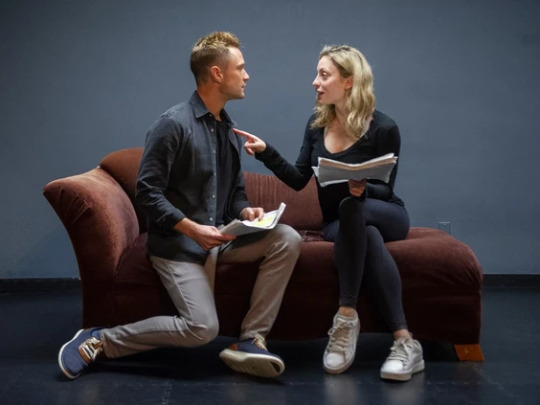
Despite the rather overt subject matter, the action is rarely as explicit as one might expect. There's very little actual depiction of BDSM and the dynamic between two partners as one might expect; it's far more suggestive in its gestures and acting. After all, it's all pretend even in the story context. Isn't it?
In 2022, themes of power dynamics, men and women in the arts, and taking advantage sexually are all front and centre of current events. In this sense the play is timely, although it was originally written and performed over a decade ago before such concepts were as mainstream. Although there are discussions of abuse, opportunistic men, and vulnerable women, the production subverts and challenges these ideas just as much as it demonstrates them. It’s (for the most part) a playful, humorous insight into exploring the heads and desires of the two roles – although to say who’s right and wrong in the end would be giving away too much.
This was the Railtown Actors Studio Lab’s first production since the pandemic, as well as my first post-pandemic Vancouver theatre experience. The intimate setting, venue, nature, and structure all contributed to a play that is personable, entertaining, and above all memorable. It’s a tale and performance that will stick with you long after the ending as the Velvet Underground song plays through your head.
Venus In Fur is on now through December 4th at The NEST on Granville Island. Tickets are available here.
Written by: Cazzy Lewchuk
Photo credit to: Arlen Redekop
#entertainment#Cazzy#Cazzy Lewchuk#Vancouver#yvr#David Ives#Granville Island#The NEST#theatre#Leah Gibson#Andrew Jenkins#Railtown Actors Studio Lab#review#show#show review#M Public Relations#bc film#yvrshoots#production
0 notes
Text
Day 10 - Vancouver
Officially today is the first day of an organised tour . . . so I had to change hotels (because this one is included in the package).
Checked out of the awesome place I spent the last 2 nights, lugged my suitcase down the street and was all checked into the new place by midday.
It wasn't far . . .
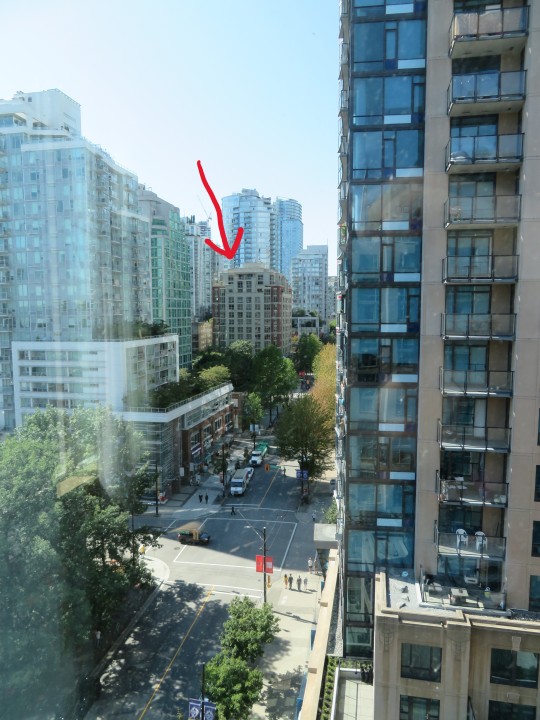
That building there is where I was staying. I can see it from the room I have for tonight!
I moved from being across the street from the Vancouver Public Library (Central Branch), to across the street from BC stadium.

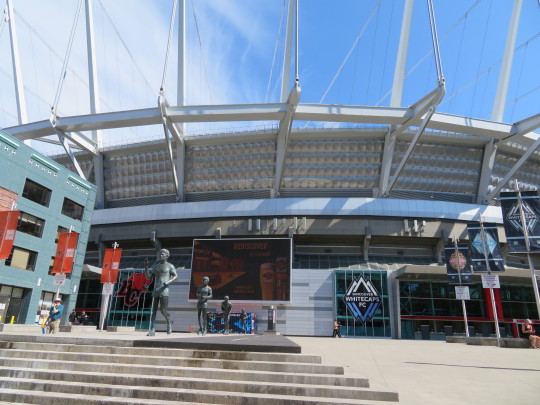
I only did a little exploring today - the Vancouver Lookout observation tower being the first.
It has a glass-fronted elevator, so that as you ride up (and down) you can see out at the city. It's kind of trippy!
The tower gives good views of the city and surrounding mountains in all directions.
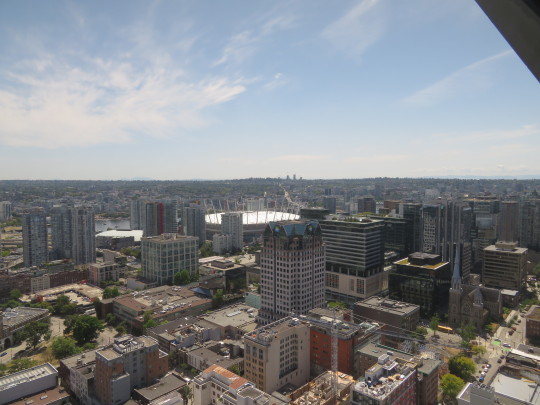
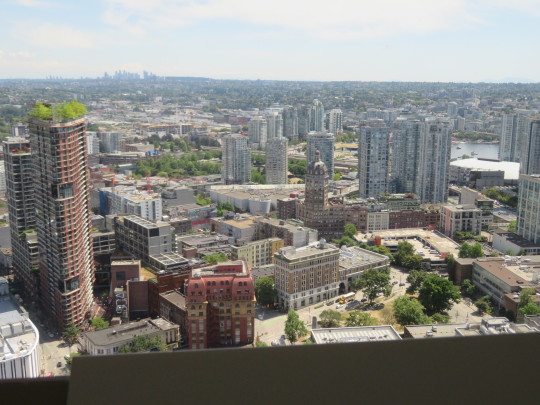
I liked the Sun Tower building and the Dominion Building (the red one in front). The goldy coloured one between them also has a name, but I've forgotten it because it's info plaque was no where near this view! A lot of the info plaques, and their little maps were not placed in relation to the view! It confused me, and many others while we were there.

The Queen Elizabeth was in town, berthed beside Canada Place.

Across the tops of the buildings is the view of Stanley Park, and over the Lions Gate Bridge to West Vancouver and the mountains beyond.
Once I'd done my 360degrees, it was back down in the elevator with a view, and down the street a bit to the Gastown Steam Clock.
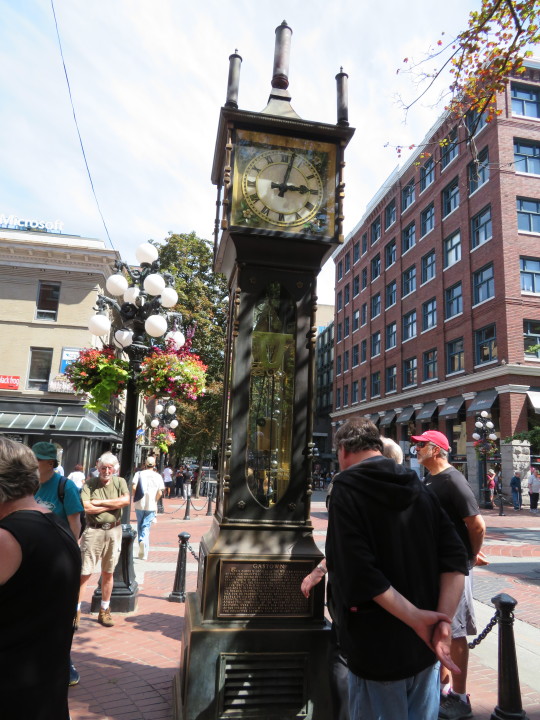
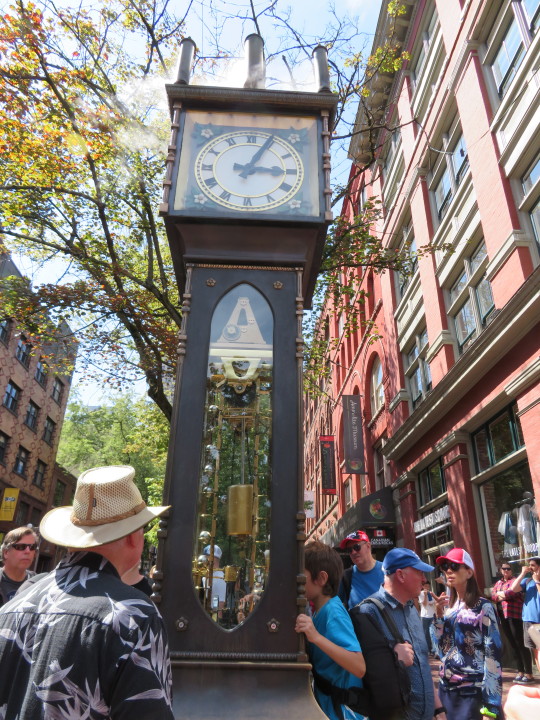

Can't upload more than one video! There is a second one - I'll try adding it to a reblog.
I wanted to get a video of the clock chiming the quarter hour so you could hear the wonderful sound of the steam whistle . . . but I missed it!
Anyway - I did head back to the hotel after that to try and get an early night because I have a super early start in the morning. We will not talk about the fact it's midnight and I have to be up at 5:30am!
#my big north america adventure#day 10#vancouver lookout observation tower#vancouver#gastown steam clock
20 notes
·
View notes
Text
Emergent trust and responsibility: three examples
…
…
Deschooling and youth liberation
A third convivial current is deschooling and youth liberation, and the proliferation of alternatives to schooling that are led by kids and youth, including those who are in school. The Purple Thistle, co-created with youth in Vancouver, Canada, has been a vibrant example of this: it nurtured a space for youth not only to hang out, but to experiment and learn together without being controlled and supervised, to take collective responsibility for running the space, and to build strong bonds with each other.
The youth-run projects included a community garden, screenprinting, photography, graffiti, zine publishing, discussion groups, filmmaking, animation, film nights, a radical library, sound and music recording, graphic design, fiber and textile arts, and more. These initiatives were emergent, based on people’s desires and priorities. carla was the “director” of the Thistle from 2009 until it closed in spring 2015, but her job was basically to do the bulk of the paper work, support and mentor when asked, and to work as kind of matchmaker connecting youth to mentors and apprenticeships both formal and informal. Overall, carla’s role as director was to function as an anchor to support the fluid and flexible relationships at the heart of the Thistle. Other adults also supported the Thistle as anchors, co-directors, and mentors, but all day-to-day decisions were made by the youth-run collective and the various pods that sprang from it. As Matt Hern, Thistle co-founder and director before carla, said of the project,
I like to think of the Thistle as being really easy in the way that school is hard and really hard in the way that school is easy. So, you go to school for example, or you go to a workplace, or you go to many institutions, you know exactly what you have to do, you know what’s expected of you, you don’t really have to think a whole lot. And that’s nice sometimes; you just walk through it: essentially just follow orders and do what you’re told and you’ll be fine. So it’s really easy in lots of ways. It’s also very difficult because that’s really hard for most people, and because you fight against it and you resist, but the Thistle turns that on its ass in lots of ways. So it’s really easy because no one is telling you what to do, you can do whatever you like, you can come and go as you like, you can figure out how you can access it. So it’s very easy but it’s also very difficult, ‘cause that’s a tremendous kind of responsibility.
The Thistle can be understood as a counter-institution, a flexible container where the participants themselves shaped roles and responsibilities in an open, experimental way. Such counter-institutions can prefigure trust and conviviality, creating space where these ways of relating can be tried out, become patterns and habits, and eventually take hold in new communities and projects.
Many of these relationships ran outside the walls of the Thistle, but were nevertheless vital for creating webs of care and mutual aid. For example, when individuals or groups found themselves in dicey or difficult situations, folks could lean on each other rather than call the cops. Often this meant supporting someone to get the care they actually needed instead of being thrown into the criminal system. Other times it meant creating space for accountability to take hold. These forms of trust and responsibility never crystallized into a public website, handbook, or formal organization; they were relational and ad hoc. We think that people are doing this all the time. In fact, in order to keep it safer for many to engage in these ways, and to hold onto these values as common notions, institutionalization or publicity is often avoided.
5 notes
·
View notes
Photo
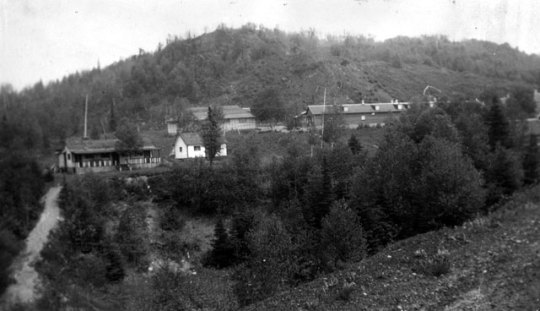





Photographs from the ‘relocation camp’ for Japanese-Canadian internees in Schreiber, Ontario, with photos digitized and put up by Schreiber Public Library. I’ve posted about the Schreiber camp before, using extracts from a great article on the subject, but here’s a recap:
“Official removal of Japanese Canadians began in March of 1942....Two days later, about 100 “British subjects” were to board a train to go from Vancouver to Schreiber, Ontario. Of the roughly 100 men ordered to board the train, eighty-five refused. BCSC officials were unable to coax the men onto the train, and ended up incarcerating them in an “Immigration Shed.” These same officials told the imprisoned men that if they did not “divulge the names of the instigators” of the action they would be hauled before the courts, but no one was willing to inform on their compatriots. RCMP Commissioner S.T. Wood then asked for a blanket Order of Internment that would allow him to formally arrest and incarcerate the men. When a push failed, a shove would apparently do. These men would go on to become some of the first of what would eventually amount to over 800 Japanese Canadians who were interned for defying the forced labour and evacuation regime.
...
By April, Dave Watanabe had already “established himself as spokesman” [at the Schreiber camp. He is visible in the second photo, second from left, middle row, identified as ‘Butch’ Watanabe] At a meeting with Graham Pipher, a British Columbia Security Commission [BCSC] apparatchik, Watanabe demanded the workers’ “rights as Canadian citizens,” mainly regarding access to the nearby town of Schreiber. The evacuees stated that their “volunteering” to work in Ontario should have earned them these promised minor freedoms. Although not described as a job action, Pipher noted that sixty people attended this “meeting” to discuss grievances when they should have been working. Building on an earlier slowdown campaign, when the workers got word that the state was to restrict their movement, they brought their working pace to a crawl and threatened to strike.
Pipher commented that any restriction “on free movement etc.” would cause unrest to become “accentuated” and that he would lose control of the camp. The central administration pondered the imposition of stricter discipline, but the notion was junked well before implementation. From the start, the camps were not jail-cum-work-camps, and the incarcerated workers had much more latitude than the authorities had intended. As the camp was “small” and lacking in guards the Japanese enjoyed relatively free mobility. The “Japs at this camp [quickly] found favour with the majority of the citizens of Schreiber,” and before long they were patronizing “local’s stores and places of amusement,” without “any adverse criticism” from the townsfolk. It was of concern to T.S. Mills, the chief engineer on the project, that the men had access to the town and the telegraph office, and had the audacity to send uncensored messages directly to their families in British Columbia.
[CW Warning: Racial slurs]
Mills related the story of a local railroad man’s daughter, who inquired of her father whether it was acceptable to dance with the Japanese. The railroader told his daughter that “as long as the Jap was sober and conducted himself properly, he would sooner she dance with a Jap than a Dago.” The railroader’s comment sheds some light on the process of racialization that was unfolding, solidifying, and mutating during the Second World War, and how the hierarchies of “race” were subject to significant gradation and shift.
Although following the war there would be an “elevation” of some “peoples” to “white” status, the war period was still riven by the hierarchies of preference and stratification within the racial-taxonomic realm. Mills “saw problems arising” and predicted there “will be cases of too much intimacy between those young, well-mannered and conducted Japs and local girls.”
Despite the reservations of Pipher and the BCSC (let alone the state) about free movement, Mills noted that “too stringent regulations at this time will cause an unfavorable condition,” and that “policies and regulations” need to be determined by need and on a local basis. Although there certainly was martial rule in the camps, and many of the people in the camps were officially interned and under much stricter control, the reality was that spaces were consistently mediated and negotiated via direct action.
The BCSC thought it impossible to restrict free movement at Schreiber camp. They believed they had a responsible partner in Watanabe as a leader, and as Watanabe had the camp’s “full support” they assumed that they could maintain rule by proxy. Nearby Jackfish Camp had a beer parlour, and the BCSC wondered if adding a pub could be enough to keep the Japanese from wandering to the local dance halls. In the end, the BCSC decided against imposing their plan of a blanket movement ban. Interestingly, the state also gave up on censoring the mail of these specific workers, unless they were sending it abroad, as the mail “could not contain information of much value to the enemy”—a freedom not extended to interned anti-fascist Canadians. Although Pipher wanted to move Wanatabe to another camp to “break” the impromptu organization, the BCSC thought better of it, noting that “should he be moved, he would cause trouble elsewhere.” Preferring to contain the trouble rather than turning local agitators into travelling organizers, Dave Wanatabe was left alone.”
- quotes from Mikhail Bjorge, “Destroying the Myth of Quietism: Strikes, Riots, Protest, and Resistance in Japanese Internment.” in Mochoruk, Jim; Hinther, Rhonda L., ed. Civilian internment in Canada: histories and legacies : an edited collection. Winnipeg: University of Manitoba Press, 2020.
Photos from top to bottom, with original captions from the SPL:
1) Gold Range Mine. Senator Hayes home and bunk houses 2 miles east of Schreiber. This became the main buildings for the Schreiber internment camp. SPL 1996.1.11.
2) Men of the Schreiber camp, 1942.
Rear L - R: 1) ? 2) Fred Vogami 3) ? 4) ? 5) ? 6) ? 7) Jack Sadoio Shikitani 8) ? 9) ? 10) ? 11) Willie Kimitoshi Utsunomiya 12) Swede Sawada 13) George Suzuki;
Middle L - R: 1) ? 2) Butch Watanabe 3) Sam Hagino 4) Fred Akira Shititani 5) Koichi Nishikaze;
Front L - R: 1) Mickey Hogara 2) George Mochizuki 3) ? 4) John Kikuo Shikatani 5) ? 6) Art Tateishi 7) Sandy Ono
SPL 1996.1.20
3) Men working at the Japanese internment camp two miles east of Schreiber 1942-1944. George Keeno on left. SPL 1996.1.12.
4) Internees at Japanese Internment Camp two miles east of Schreiber. Men were sent to the camps to assist in road building in the area between Schreiber and Jackfish. SPL: 1996.1.19.
5) Left - Right: Minoru Nagasawa , Matahuru 'Mutt' Otsu. Taking a break from chopping wood, 1942.
6) Some of the residents of a Japanese internment camp, during World War II. The camps were outside of Schreiber, about 2 miles east on Highway 17.
Standing L - R: 1) Doug Arai 2) Punchy Ito 3) Don Otsu 4) Mitsuo Otsu 5) Len Takeshima 6) Maise Nishimura 7) Syd Nishimura. Seated L - R: 1) Larry Makino 2) Ernie Dikawa 3) George Nishimura. Some of the residents of a Japanese internment camp, during World War II. The camps were outside of Schreiber, about 2 miles east on Highway 17.
SPL: 1996.1.18
All photos Schreiber Public Library.
#japanese canadian internment#internment camps#japanese canadians#canadian history#prison camp#japanese immigration to canada#nikkei#nikkei kanadajin#canada during world war 2#dictatorship within democracy#defence of canada regulations#northern ontario#schreiber#work camp#racism in canada
93 notes
·
View notes
Photo

Thanks to the Seattle Art Book Fair, who invited us to create this installation to highlight our recent PoMo Pulp series of art zines for their inaugural fair!
From the installation description:
Po-Mo Pulp is a series of zines published by Neoglyphic Media, which will be featured through an exhibition of conceptually-related original work, intended to expand the context for the publications. The visionary nature of the artists involved grinds against the subversive voice of the underground and begs for further exploration along the line of where low-brow or pulp media crosses over into fine art.
The exhibition will feature publications paired with original art and multimedia work on display from artists:
Amanda Vähämäki (Finland)
Lale Westvind (Philadelphia, PA)
Drew Miller (Albuquerque, NM)
Leomi Sadler (London, England, UK)
Marc Bell (Vancouver, BC, Canada)
Matt Lock (Clifton, NJ)
Stefan Gruber (Seattle, WA)
Copies of these zines are available from the Neoglyphic Media webstore!
#NeoglyphicMedia#PoMoPulp#AmandaVahamaki#LaleWestvind#DrewMiller#LeomiSadler#MarcBell#MattLock#StefanGruber#SeattleArtBookFair
12 notes
·
View notes
Photo




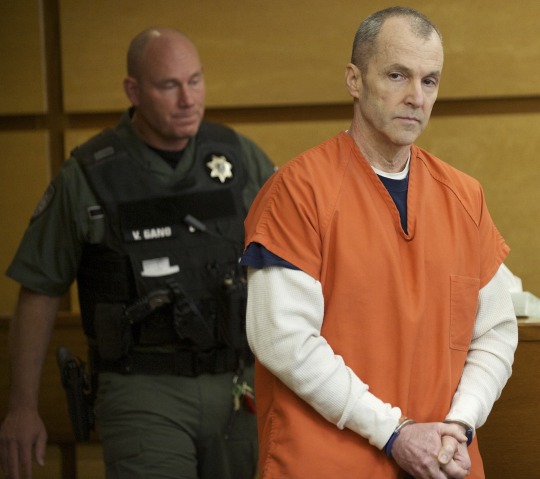

Post 794
With sworn public safety officers, even though the burden of proof is lesser than in criminal court cases, the evidence here is insufficient and reinstatement is ordered. -- Arbitrator
Kenneth Garrison, Washington inmate 380441, born 1963, incarceration intake in 2015 at age 52, sentenced to 10 years, scheduled discharge date not available
Child Molestation
A former lieutenant with the Washington State Patrol was sentenced to more than 10 years in prison for sexually abusing two relatives.
Judge Robert Lewis sentenced Kenneth S. Garrison to the maximum penalty for his crimes, which is a minimum of 130 months but up to life in prison. After serving just less than 11 years behind bars, Garrison’s release will be decided by the Indeterminate Sentence Review Board.
He pleaded guilty to first-degree child molestation, first-degree incest and possession of depictions of a minor engaged in sexually explicit conduct.
Garrison, 52, was most recently the lieutenant responsible for supervising troopers who patrol the Southwest Washington district, which is headquartered in Vancouver. When the sex abuse allegation surfaced in December 2013, Garrison resigned from the State Patrol. A month later he retired from his position as a lieutenant colonel in the Washington Army National Guard.
In exchange for his guilty plea, Senior Deputy Prosecutor Camara Banfield dropped charges of another count of first-degree incest, second-degree incest, second-degree rape and eight counts of possession of depictions of a minor engaged in sexually explicit conduct. The child pornography was found on Garrison’s phone when he was arrested, Banfield said.
Friday’s prison sentence is punishment not for only local sex crimes but also for crimes that occurred in neighboring Cowlitz County nearly 15 years ago.
When detectives began investigating the sex abuse allegations in 2013, the Cowlitz County Prosecuting Attorney’s Office reviewed a 2001 case in which Garrison was accused of touching the private parts of a 6-year-old relative while the child was sleeping, according to court papers.
Garrison was charged with the crime in Cowlitz County more than 10 years ago, but the charge was later dismissed.
The 2001 allegation against Garrison led to an internal investigation by the Washington State Patrol that ended in Garrison’s termination, according to personnel records. Garrison was fired in 2003 and then decertified as a peace officer, State Patrol spokesman Bob Calkins has said.
In an internal investigation, the burden of proof is lesser than in a criminal court case. Garrison’s supervisor at the time reviewed the 2001 allegation and determined that there was enough proof that the sex abuse happened, Calkins said.
However, when Garrison appealed his termination, an arbitrator ruled in his favor, awarded him some back pay and ordered him back to work, according to his personnel records. He returned to duty with the State Patrol in 2008 and remained with the agency until his resignation in December 2013, when the new sex abuse allegations surfaced, Calkins said.
Investigators began investigating Garrison in 2013 when a different relative alleged that Garrison had sexually abused her over the course of seven years.
Detectives arrested Garrison in January 2014 at the Rodeway Inn and Suites in Gresham, Ore., on suspicion of sexually assaulting a relative between 2006 and 2013 in Clark County.
Prosecution of the Cowlitz County case was handed over to the Clark County Prosecuting Attorney’s Office for efficiency purposes, Banfield said. The first-degree child molestation conviction was related to the older case, according to court papers.
The victims in both cases were in the courtroom for Friday’s sentencing and the victim in the Cowlitz County case spoke to the judge, ultimately saying that she and her parents forgave Garrison for the damage he caused.
When given the opportunity, Garrison did not speak at his sentencing hearing.
Though Banfield and Garrison’s attorney Shon Bogar had come to a negotiated plea agreement that recommended 10 years behind bars, Lewis implemented the maximum sentence, adding nearly a year to Garrison’s sentence, including the possibility for life in prison.
Lewis said his sentence was not due to devastation to parents or embarrassment to law enforcement, but was on behalf of “the two young women who were here today and the thousands of children who are subjected to sexual abuse to feed the child pornography industry in this country and throughout the world.”
The sentence includes a lifetime no-contact order with the two victims and a requirement that Garrison register as a sex offender until he is otherwise notified by the court.
2d
11 notes
·
View notes
Text
An Arby's manager admitted to urinating at least twice in the company's milkshake mixture, according to a report from the Vancouver Police in Washington.
The police said in a press release that they obtained footage of the night manager, Stephen Sharp, urinating into a milkshake mix container. Sharp confirmed the incident with police and said he had done it for "sexual gratification," according to the release.
The Vancouver Police said they are looking for individuals who may have purchased the contaminated milkshakes on October 30 or 31 of 2021 at the Arby's location at 221 Northeast 104 Avenue, Vancouver, Washington.
Local news outlet The Columbian said that on the day Sharp allegedly contaminated the mixture between 30 and 40 milkshakes were served and cited a statement from another manager at Arby's that was taken in court on Wednesday. Sharp said he was "almost sure" that he disposed of the mixture after urinating in it, but he also said that if it wasn't thrown in the trash it would have been served the very next day, the publication reported.
An Arby's spokesperson did not respond to a request for comment from Insider, but told Fox Television Stations Sharp's actions were "abhorrent and unacceptable."
"We have taken immediate action with the franchise group who terminated the former employee and is fully cooperating with the authorities in their investigation," an Arby's spokesperson told the publication.
The police force's Digital Evidence Cybercrime Unit said it has not found any evidence that Arby's or the specific franchise were aware of the issue. Insider was unable to reach Sharp for comment. The Vancouver Police did not respond to a request for comment.
The police said they initially found evidence that Arby's milkshake mix had been contaminated after their Digital Evidence Cybercrime Unit began investigating Sharp over allegedly possessing and selling photos and videos related to "the sexual exploitation of children." The unit alleged at least one image was downloaded within proximity of the Arby's restaurant.
Last week, Sharp confessed to downloading and distributing the images, according to the police. He has since been booked into Clark County jail on four charges related to child pornography. The police said the investigation is still underway.
___________________
These milkshakes will not be bringing the boys to the yard, the boys will be staying away from them.
That bit at the end there was a gut punch though
17 notes
·
View notes
Note
a b and c!
A is for Ally!
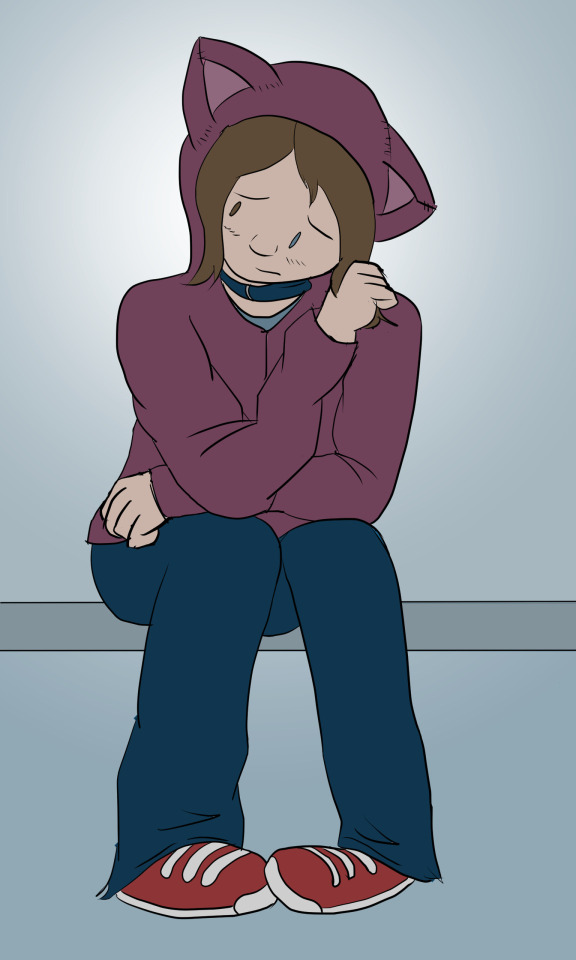
Ally is one of the few OCs I made before Blaseball forced me to. Ally's human but she doesn't really relate to them. She's got heterochromia, and kids were really mean about it when she was growing up. But the furs at her school weren't really fazed by it, and were happy to make friends with her. It kind of stuck, and she mostly hangs out with furs (hence the ears on the hoodie and the collar). She's a photographer, and has sold some of her pictures to magazines and other publications.
B is for Bourbon!
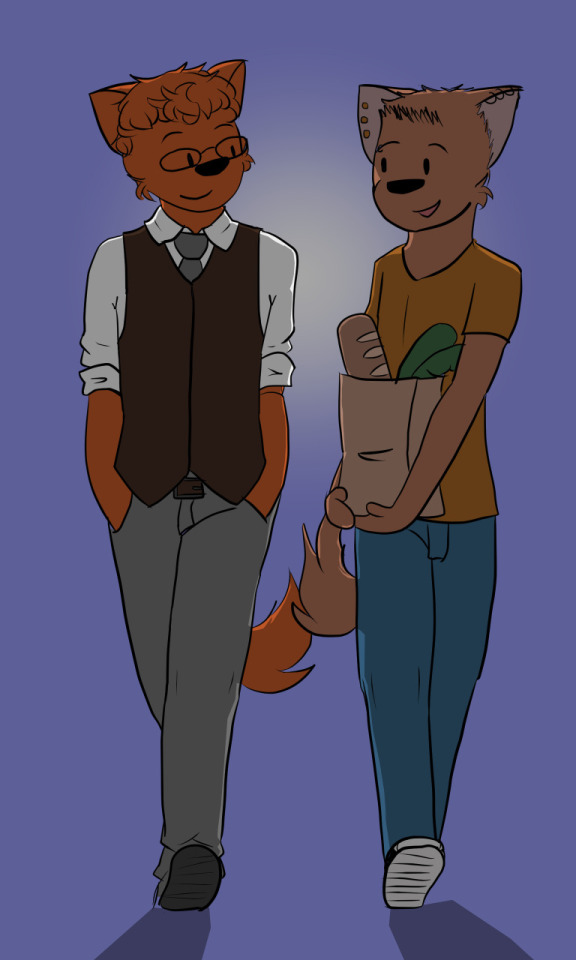
(Bourbon on the left, Fink on the right)
Bourbon is a punk kid made good. He grew up a queer kid in a religious foster home, got into a lot of stuff he shouldn't have, but eventually fell in with a group of friends who saw the best in him, and took care of him. He manages to get out of the States for university, meets the love of his life, and lives quietly in Vancouver.
Bourbon's charismatic, gregarious, even flirty. He tends bar, and is really good at it. He picked up a cigarette habit when he was in his teens, and is trying to kick it, though he occasionally relapses.
I mentioned he's flirty, but he's actually pretty ace. He's not really interested in sex, he just likes the attention that flirting gets him. He is madly in love with Fink, though.
C is for Charlie!

Okay so Charlie's story is called "I was young when I came up with this, and I'm sorry."
Originally, Charlie's whole thing was she was a model for a site called Lithium Girls (like for depression? Instead of Suicide Girls?? GET IT???). She made a good chunk of change doing that, finds a guy, Jon, in Ally's (and Bourbon's) friend group, and also finds a stable life. (None of her friends care she did low key sex work, it's really not that big of a deal).
Charlie's also a gamer, and loves retro games, especially Sega consoles. Eventually, she takes the savings she made from Lithium Girls and opens a retro game store in Denver. She's super cool, confident, unflinchingly tomboyish and geeky, and at least one of my other OCs has a huge crush on her. She's also the oldest of that friend group, at 5 years or so older than Jon and Bourbon and Ally.
Thanks for asking!
2 notes
·
View notes